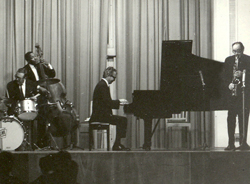
Bartlett: What was the typical recording and editing procedure in those days?
Wilder: Recording back then was almost a factory process. They recorded live to 3-track in three-hour sessions.
Then the tape went to the editor, then to the mixer, who mixed three tracks to two. Little or no compression was used.
We compared the master tapes with early pressings, and they were very similar. It’s amazing how little the mastering engineers did to the sound.
By the way, Columbia’s acetates were quiet as digital, even though theory says they aren’t supposed to be.
Studio engineers worked so fast back then. They might record Duke Ellington in the morning, Doris Day in the afternoon, and Brubeck the next day. There was only one hour between sessions, and each session had a totally different setup.
In spite of the speed of these sessions, you never hear a blown solo or a blown fader move. And there’s never a dramatic sound change at an edit point.
Bartlett: Who were the engineers on the Brubeck sessions?
Wilder: Fred Plaut and Frank Laico were two of Brubeck’s recording engineers. Plaut is a true balance engineer; he’s my idol. I don’t know how he could pull off what he did in three hours.
Besides Brubeck, another artist whom Plaut recorded was Michael Olatunji. He was an African drummer who made ethnic cultural records. When I listen to them, I’ve never heard drums sound so beautiful in my life—such color and harmonics. Why can’t I pick up a record today and hear that?
Plaut did a lot of Broadway recordings, and he worked so fast. Here’s an example. Friday night after a Broadway theater performance, the actors would come over and record all night. Then the artists would go back to the theater for the next performance. By Monday morning, the records would be edited, mixed, cut, and on the shelf ready to be trucked out.
Eight-track recording was introduced in the late ‘60s. Plaut backed up his 8-track recordings on a 3-track recorder. He always ran a 3-track as a safety.
I listened to some of his 8-track recordings done in the late ‘60s. The 8-track is a mess, but the live-mixed 3-track has perfect balance and blend.
